Everyone loves mücver! These moist and delectable zucchini fritters with feta cheese are easy to make and even easier to eat.
If immersing myself in the cuisine of Turkey for six years has taught me anything, it’s that everyone loves mücver. These simple but delicious courgette fritters are a beloved feature of home cooking and restaurant menus alike.
And, obviously, it doesn’t stop with the Turks.
The recipe for mücver is easily one of the top 5 most popular recipes among my Norwegian language readers. Most of them would never have tasted the dish until they came across my blog or first book. Now, it’s a true summer staple for many of my readers who’ve never been to Turkey, too!
There’s something so comfortingly delicious and familiar with these that everyone just loves them. Children, adults, veggie lovers and veggie skeptics – everyone seems to agree on their love for the humble Turkish courgette fritter.
What is mücver?
Mücver are Turkish style vegetable fritters. They’re made from mixing your vegetable(s) of choice with an egg and flour based batter.
The most common version is kabak mücver, or courgette (zucchini) fritter. Indeed, this version is usually just referred to as mücver. It’s all the other versions that need to have the name of the main ingredient added beforehand. Pancar mücveri for beetroot fritters, for example.
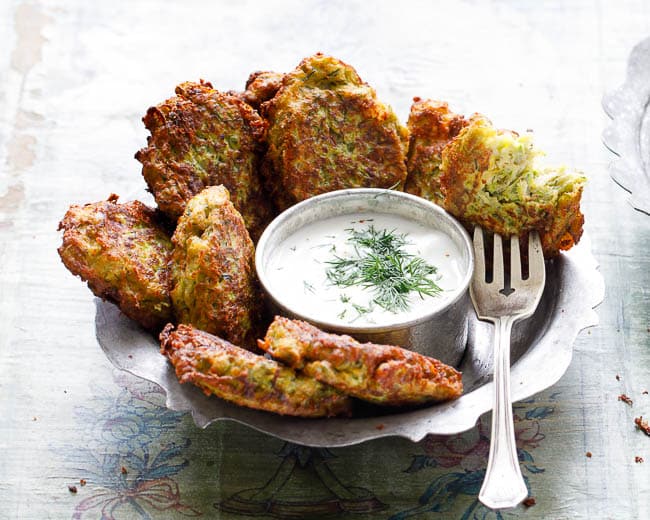
The mild flavour of courgettes is much like a blank canvas which can be taken in any direction. Where you choose to take them, depends on what you’re after.
These beautiful courgette fritters (zucchini fritters if you’re in the US) can be made soft and scrumptious, much like rather large but flat meatballs or small burgers. Or you can turn them into crispy balls with a fluffy interior. Or anywhere in between.
The home made version is typically that of the former. It’s easier to make and more versatile, as it can be eaten hot or cold. That’s also what you’re getting the recipe for in this post. The deep fried, crunchy stuff, while absolutely delicious, is best left to restaurants.
Not to forget, you should flavour your fritters, too. Herbs, spices, cheese, onions – even other shredded vegetables – all help make mücver all the more irresistible.
More on that later.
How to make Turkish courgette fritters (zucchini fritters)
They key to a successful courgette fritters starts with step one: Shredding the courgettes and draining them of most of their juices.
Every once in a while I’ll have someone complain that the fritters didn’t come together, or were impossible to cook through. In those cases, the courgette water is often the culprit. They simply haven’t managed to squeeze enough water out of their courgettes before adding them to the batter (or adjusted the recipe by adding more flour to compensate).
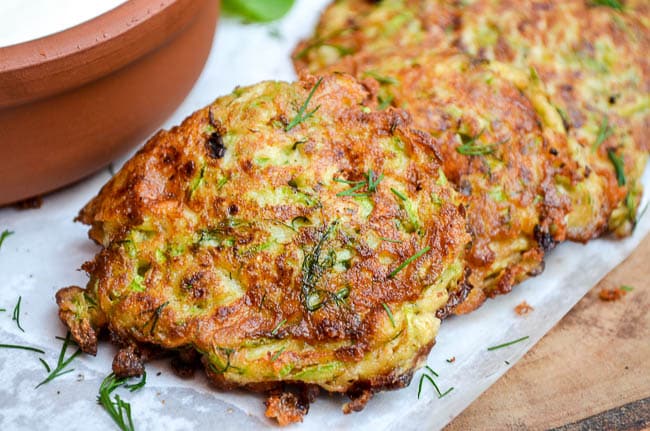
A word of advice, therefore: It’s possible to squeeze a lot more water out of a courgette than you think! Keep the pressure up for a little while at each squeeze – sometimes it takes a second or two before any liquid comes out. But when it comes, it still does in droves!
For me, this process usually takes around five minutes for this recipe. The shredded courgette should lose at least ⅓ of its weight in the process.
Once the squeezing’s done, though, the hard work is pretty much done. Easy sailing from here on in!
All you need to do is add your eggs, flour and flavourings. Make sure anything chopped is very finely chopped. (Nobody likes a chunky pieces of half cooked onion.)
Flavourings for kabak mücver
In Turkey, we use the bright green type, but any type of courgette will work. Remember that younger (smaller) courgettes usually have more flavour (and less water) than bigger ones.
Once you’ve got your base ready, it’s up to each cook where to take it. There are some common denominators that usually pop up, but mücver is one of those recipes where it really depends who you ask. Everyone’s got their own favourite versions, their own little flavouring tricks.
Onions are requisite, though which allium to choose is entirely up to you. Just make sure to finely chop them so you don’t get any raw tasting chunks of onion in your finished fritters.
Herbs provide not just visual interest with its speckles of green, but also carry much of the flavour of courgette fritters. Dill, fresh or dried, is probably the most common addition. A pungent herb though it is, it goes really well with the more humble flavour of the courgettes and batter. I certainly like adding it to mine when I’ve got dill sitting around.
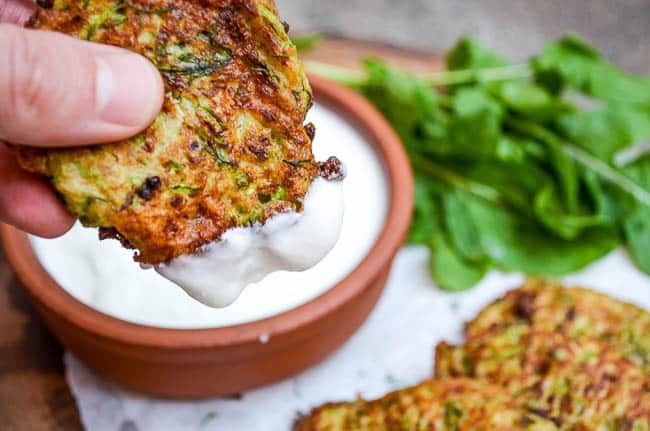
Flat-leaf parsley would also work well. Some people put mint in their mücvers, though that risks dividing opinion on the deliciousness of the fritters. I suggest sticking with the dill or (less tasty but even safer) parsley.
A little cheese is another great and popular addition. It adds both depth of flavour and delicious seasoning. Turks will usually use beyaz peynir (lit. “white cheese”).
Beyaz peynir is a crumbly and salty cheese which is very similar to feta cheese. There’s an almost endless variety to this style of cheese, from the hard to the semi soft to the spreadably soft. Most versions today are made with cow’s milk, but you can also get them made from sheep’s or goat’s milk.
The crumblier version very similar to the better known feta cheese is usually used for mücver. As such, feta cheese is an excellent stand-in. It is indeed common in kolokithokeftedes, the Greek version of the same dish, which is typically more herb laden than its Turkish counterpart.
Then there are the spices. The Turkish kitchen is – surprisingly to many outsiders – perfectly happy to omit spices from most of its dishes, relying instead on clean flavours and excellent pairing of main ingredients. As such, many versions are completely without spices. Others may add a pinch or two of pul biber (Aleppo pepper) or paprika.
Taking a cue from Ottolenghi’s version, which claims no authenticity or inspiration from the Turkish classic, I’ve long added ground coriander to mine. It adds a subtle citrus-y note which I think goes really well along the oil and cheese. Nutmeg would be another excellent option, though I’d use considerably less of that than I do coriander.
Finally, do not skimp on the oil. Not in amounts, and not in quality. These fritters are shallow-fried. This means the oil doesn’t just provide a vehicle to brown the fritters, but are also an important component in how your fritters will taste in the end.
If you want a light and delicious tasting mücver, you’ll need to use a decent quality olive oil here. I use a mild extra virgin olive oil from Ayavalık in Western Turkey, which has very much the same environment where a lot of the Greek Kalamata olives are grown.
How to serve mücver
Mücver can be eaten hot or cold, and at any occasion. Really!
Before delving into the various ways of eating it, though, I’d like to point out that this dish is perfect for if you’re serving veggie skeptics. When I say that everyone loves mücver, I really mean it. Including the meat-only eaters!
Personally, I usually serve mücver as one of two or three vegetable dishes for dinner. All I need alongside is a big bowl of yoghurt and a wholesome salad (don’t forget the proteins!) and something fresh.
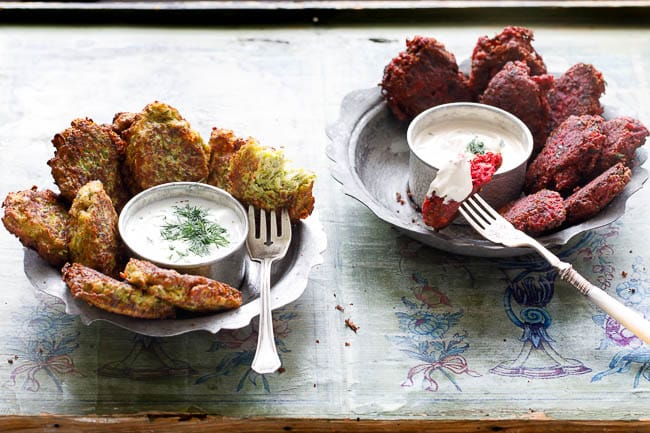
Try spiced chickpeas with chopped salad (both in one!), or another legume-based dish such as musabaha or lebanese moussaka with a Turkish shepherd salad alongside. Another brilliant option is kisir, the Turkish bulgur salad related to tabbouleh.
I also love bringing the fritters along for summer picnic (see above: everyone loves mücver). They keep really well, even at room temperature, and are easy to eat without cutlery. But don’t forget the napkins to avoid getting greasy!
And you know what? There’s nothing better than finding a few leftover courgette fritters when you open the fridge for that midnight snack…
The recipe makes around 12 zucchini fritters, enough to serve 3-6 people.
Try these as well:
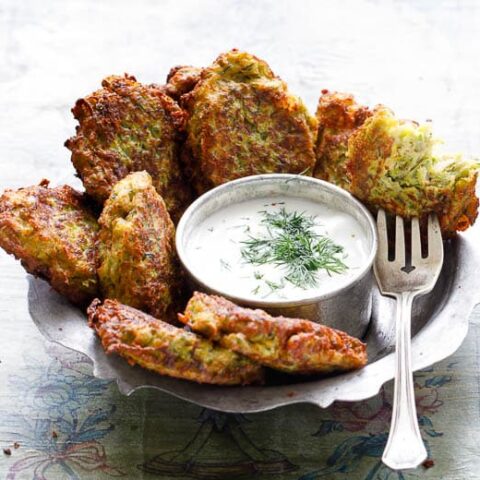
Mücver (Turkish courgette/zucchini fritters)
Ingredients
- 600 g courgette (zucchini), shredded (c. 3 medium sized)
- ½ medium onion, shredded
- 60 g white flour
- 2 eggs
- 2 tsp ground coriander, (optional)
- 3 Tbsp chopped dill, (without stalks)
- 75 g feta cheese, crumbled (a salty goat’s cheese also works)
- 200 ml Greek yoghurt
- olive oil, to fry
- salt and pepper
How I make it
- Mix the shredded courgettes with 1 tsp salt. Leave to drain in a colander set on top of a bowl for 10 minutes.
- Squeeze most of the water out of the courgettes. It’s easiest to do this by putting it in a clean cheesecloth or kitchen towel. Keep in mind you can usually squeeze out a lot more than you think! After the first few squeezes, you’ll need to keep the pressure up for a few seconds before any liquid comes out. The courgette should lose at least ⅓ of its weight in the process.
- In a bowl, mix the shredded courgette, onion, flour, egg, ground coriander, dill and some pepper with a fork or whisk. Carefully fold in the cheese. Feta will usually provide enough salt, but add a little if your salt isn’t very salty.
- Heat a thick bottomed large frying pan over medium heat. Add plenty of olive oil (you should cover the base by c. ½ cm (⅕ in)). Make a tiny test fritter to check for seasoning. Once you’re happy with it, use a tablespoon to scoop out the courgette mixture and into the frying pan, flattening a little once in the pan. These are rustic fritters, so don’t worry too much about the shape. The fritters should be the size of a small burger. Fry until golden brown on both sides, around 5-7 minutes in total. Transfer to a plate covered with kitchen paper to drain any excess fats.
- Serve at room temperature alongside a small bowl of yoghurt.


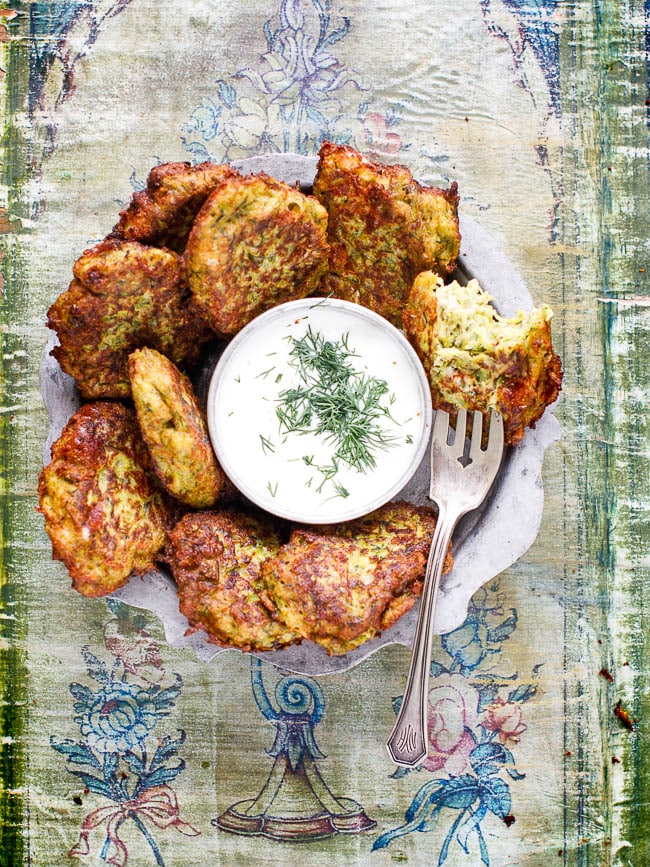

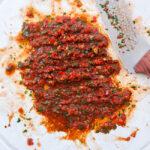


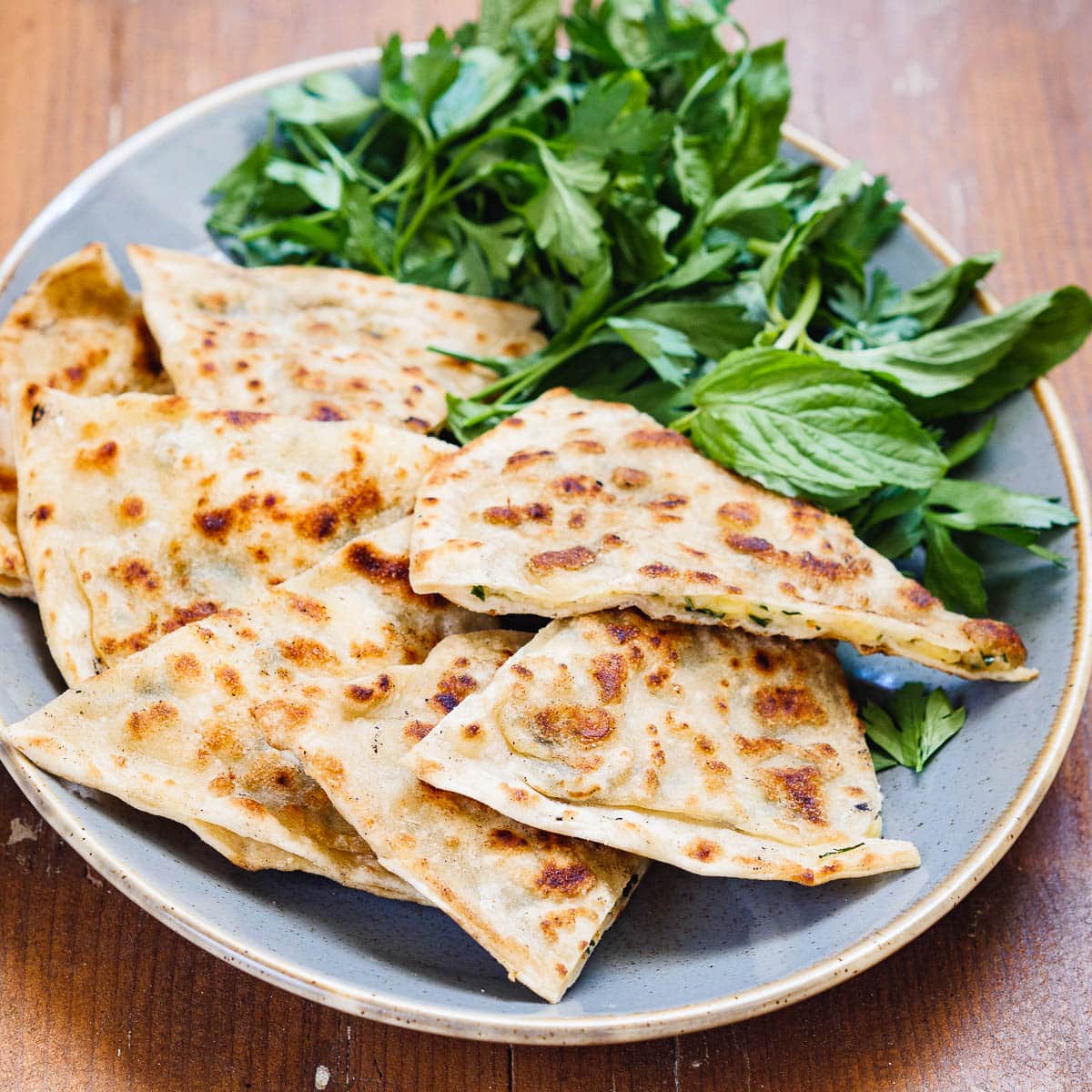
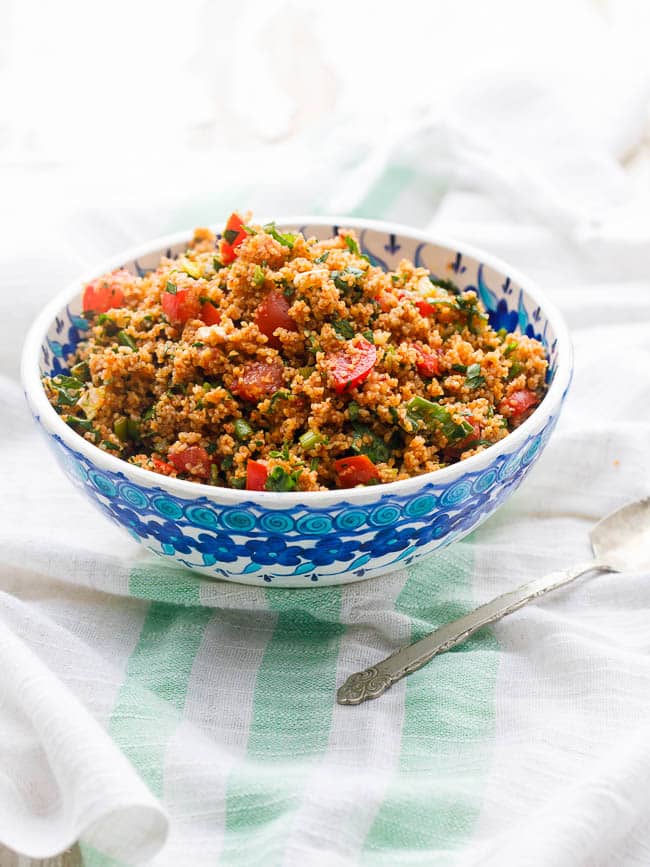
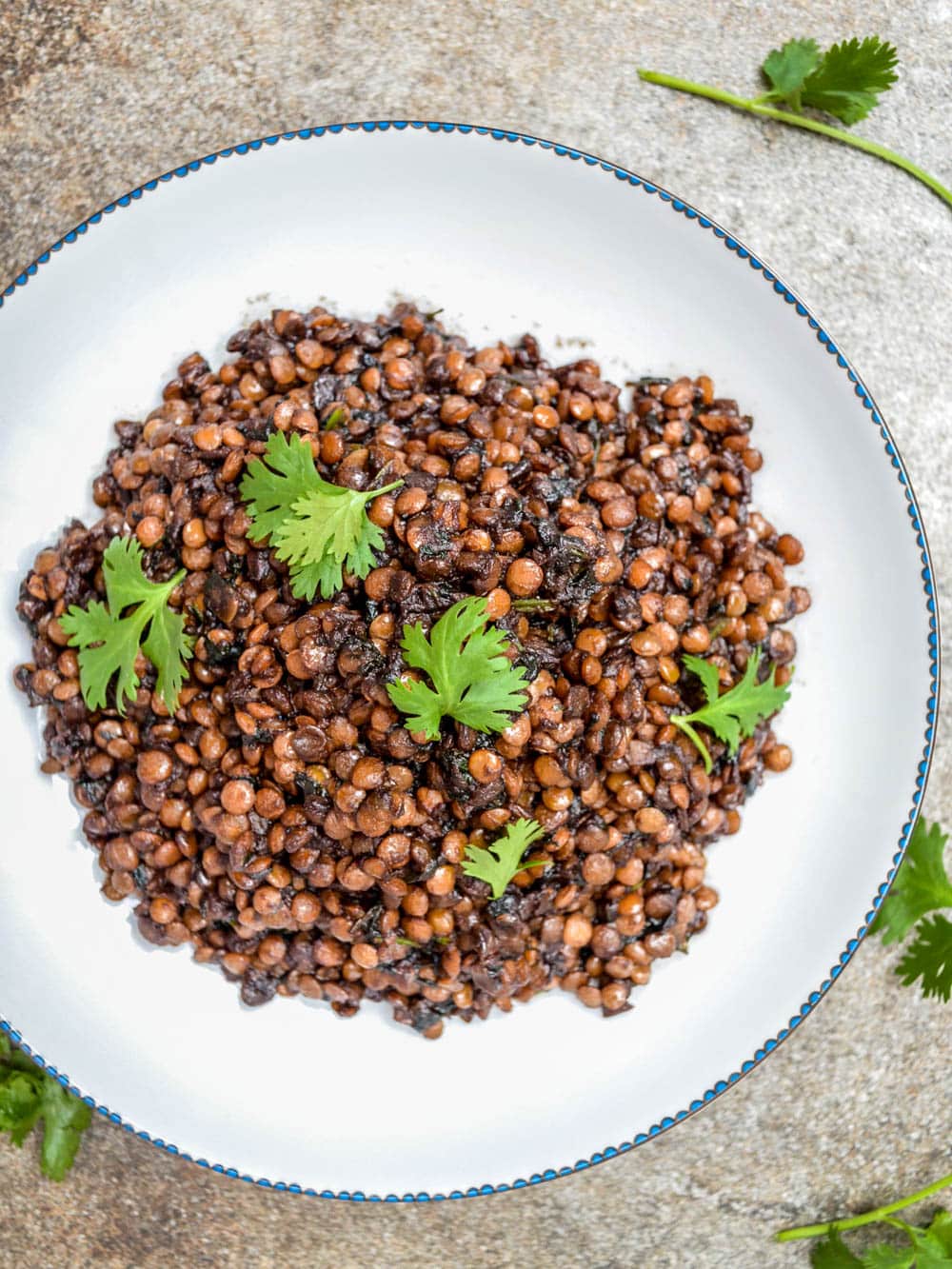
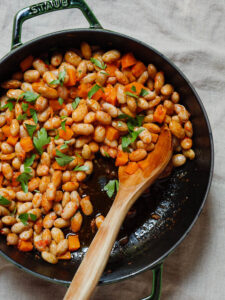
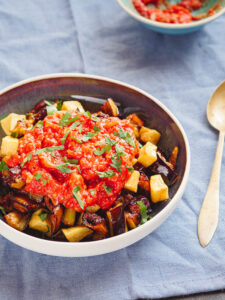
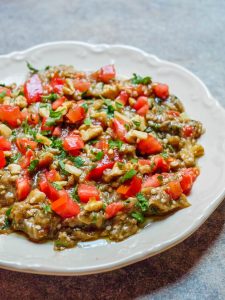




18 responses
What a delish way to use up my courgette and onion glut. Will deffo be makomg more of these as they are being gobbled up by the family now.
Excellent! Delicious and easy way to use up a courgette glut!
I’ve tried approximately zillions of Zucchini fritters over the years. I’m happy to say, I’m screaming to a halt in front of this one ! By far the best ! Great recipe that works and love the texture and taste. Thank you for simplifying my life ! PS I don’t always have access to good Feta, so I have tried with a few other cheeses (I’m in France), some that are not even close to Feta, all worked a treat.
Wow, that’s wonderful to hear! Made my day! Thanks so much for sharing 🙂
Yes, that was really delicious. I made it with home grown ingredients and added some roasted beetroots and baby red onions to the plate – colourful, fresh and so tasty. Thank you, I’ll be looking at your other recipes 🙂
Hello Vidar, somehow I found myself reading your recipes 🙂
I realised you said onion… maybe there was a typo but couldnt help myself, it should be spring onions. Not the regular onion
I hope you dont mind:)
Thank you!
Hi Gizem. There are as many ways of making mücver as there are people making them 🙂 A lot of people use spring onions, others regular onions. Most people I know use the latter, and that’s my preference here, too. I want to add the savouriness of onion without the popping flavour of spring onions. But as with most foods as widespread as this one, everyone has their own way and preference 🙂
Hi. Ate some great mucver at a Turkish restaurant in Dalston, London so hunted for this recipe. Question: do they freeze?? Thanks
I don’t, but I know people that do. So the answer is yes, but they probably won’t have exactly the same texture after being freezed/thawed. Good luck!
Haha, that’s why I’m here too as I used to eat the best mucver at Evin restaurant in Dalston and since leaving London I miss it so much! It was better even than the ones I’ve tried in Istanbul!
Hello Vidar,
I am planning to try out this recipe, was wondering if you could suggest an alternate for eggs as we are vegetarian 🙂 appreciate the help
Hi, I’m afraid eggs are an integral part of this recipe so I’ve never made them without. Suggest having a look at vegan websites, which I’m sure will have advice for a good substitute. Best of luck!
Love the mucver!! I find if I toast the flour for 7 to 8 minutes in a 360 oven they don’t have a bit of the raw flour taste. Thank you.
Love your recipe for mucver! This is definetly the best one I have tried. I do recommend eating it with garlic yogurt, yum! Love your website, your Insta, and your emails! Thanks so much
Hello Vidar, We really enjoy your website and recipes. Zucchini recipe tonight, another favourite is Soslu Patlican. Planning to do your beetroot fritters soon. Keep posting! Regards Sheila ( live in Sheffield Uk)
Hello Vidar, I love the web site and I love zucchini fritters. I am a Yorkshireman living in Oz(traylia) and would like you to know that we are familiar with the term courgette as well as zucchini.
I am multilingual and I appreciate when native speakers correct my linguistic mistakes. I’m sure that you won’t mind me letting you know the zuccini is really an American term and is the plural, so there are three zucchini in your recipe and not zucchinis. Actually the Italian plural is zucchine. Keep up the good work and cheers, Alfred. https://www.wordsense.eu/zucchina/
Thank you! Appreciate it and mistake corrected, though according to Merriam Webster zucchinis is an accepted plural form in American English 🙂
Hey, this is literally a food blog, stop ruining people’s appetites with your pedantic comments and be grateful someone’s out here sharing their knowledge, culture and time with us FOR FREE.